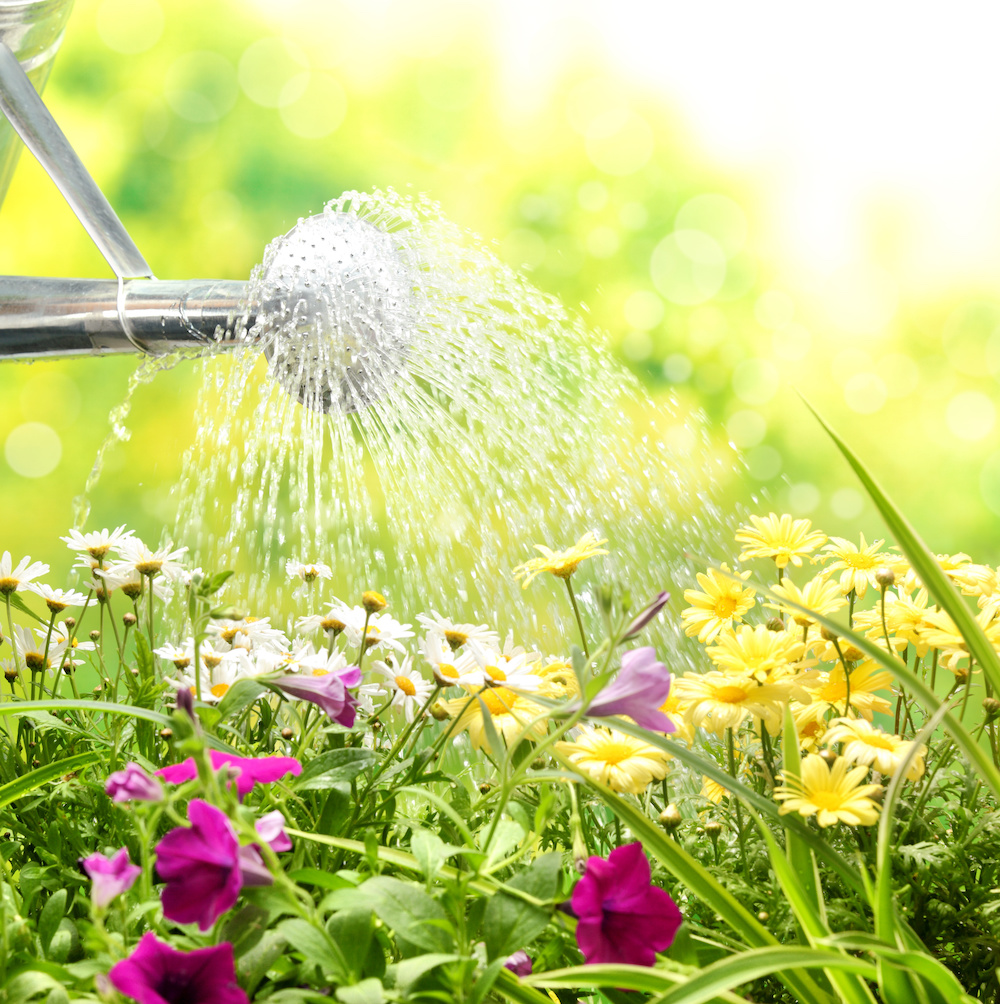
Water is unquestionably the lifeblood of every tree, shrub and plant on earth, the indispensable element that enables plants to survive and grow. All plant tissues are comprised primarily of water, and experts tell us that plants disperse into the air through transpiration 90% of the water they take-up. Accordingly, to maintain healthy plants in your garden, an adequate supply of water must be continuous available to meet their needs. Weather in New England is always unpredictable, and we typically have significant periods without rainfall, as we’re currently experiencing.
Diligently monitoring and adjusting the adequacy of soil moisture around your plants significantly enhances your likelihood of having a healthy, vibrant garden. Here are some tips to help assure your plants receive sufficient water to thrive.
New plantings
Ensuring the roots of recently-planted trees and shrubs effectively contact their new surrounding soil is imperative to enable them to start taking-up water–a thorough puddle-in soil-soak at planting is desirable, as it also reduces trapped air that impairs soil-root contact. Some horticulturists recommend flooding the freshly-dug planting hole with water after adding amendments and prior to setting the roots; others soak the area once the root-ball is in place; either method is effective. Always follow recommended planting guidelines (available at your local garden center) for balled-and-burlapped or container-grown plants. And importantly, be sure to build a water-retaining saucer or berm around the base of each plant to corral water, assuring it will penetrate effectively into the root area. Check soil around newly-planted ones for adequate moisture 2-3 times a week for the first year. We’ve also had encouraging reports from those who use Hydretain when installing their plants.
The first year
Give your new plantings a consistent weekly watering, always applying at least an inch. This helps enable their root systems to become established. Some types of plants may need more frequent watering, particularly during the first several weeks following installation and when no rainfall occurs. Clayey soils tend to require less frequent watering than sandy soils, but never allow the soil in the root zone to become dry: dig down 3-4 inches in the root area to feel the moisture in the soil with your hands, and add water if the soil is overly dry and crumbly. Also, be sure not to over-water and drown the roots if the soil feels soggy.
Here’s how much water to use on your newly planted trees and shrubs at each application:
· Small shrubs up to about 3 ft. high and wide: 4-5 gallons
· Large shrubs over 3 ft.: 7-10 gallons
· Small trees less than 2” stem diameter (caliper): 7-10 gallons
· Larger trees more than 2” caliper: 10-20 gallons
Landscape plants are not particular about water quality. As an alternative to using expensive potable water, try using recycled captured runoff from your roof, washing machine, bathtub or car-washing.
Drought
Extended dry spells, even a few weeks in the growing season without rain, can create serious survival risks, both for those recently-planted, and also for more established plantings. Adding organics like compost at planting time always helps to retain moisture, and applying a 3” to 4” deep layer of mulch after planting aids in reducing soil evaporation. Drooping foliage/shoots, curled-up leaves and grey-toned or discolored foliage are all symptoms of inadequate moisture and indicate that a dose of water must be provided immediately. Some soils can become dusty-dry in extreme droughts, at their worst feeling and acting like sifted flour or talcum powder.
When soils become excessively dry they can’t readily absorb water; they need a slower application that soaks-in gradually and doesn’t simply run off; this is where the water-retention saucer/berm around the base of the plant shows its true worth.
Continuing maintenance
Even with optimum supplementary watering, no irrigation regimen can compare with the value of natural rainfall which affects the entire soil environment, not just the limited zone around the individual plant’s roots. And it’s easy to be deceived by automatic irrigation systems: plants require periodic deep water penetration that reaches their roots, not the mindless, recurrent, often daily (!) shallow sprinkling that most of these systems provide (and homeowners unfortunately believe are adequate). Ensuring an inch of water once a week is a reasonable general guideline.
Lawns, shallow-rooted and all potted plants, including herbaceous perennials and “color” annuals, generally need more frequent irrigation. Pay particular attention to these in periods of sparse natural rainfall: they dry-out rapidly and require more diligent care than most trees and shrubs.
Winter soil moisture
As they enter dormancy in late autumn, plants require sufficient moisture to assure they can endure the upcoming winter weather stresses until the next spring’s growing season returns. Sometimes the result of insufficient winter soil moisture becomes evident in spring when a plant is very slow to leaf-out or unexpectedly dies.
About the Author
Wayne Mezitt is a 3rd generation nurseryman and a Massachusetts Certified Horticulturist, now chairman of Weston Nurseries and owner of “Hort-Sense”, a horticultural advisory business. He currently serves in various capacities on several horticulturally-related organizations, including the Massachusetts Horticultural Society at The Gardens of Elm Bank in Wellesley MA and as chair of the Massachusetts Invasive Plant Advisory Group (MIPAG).







